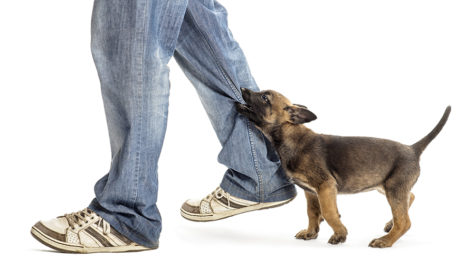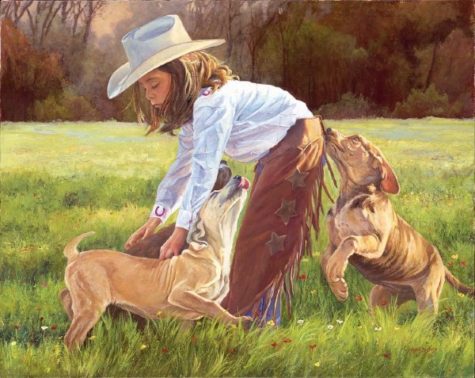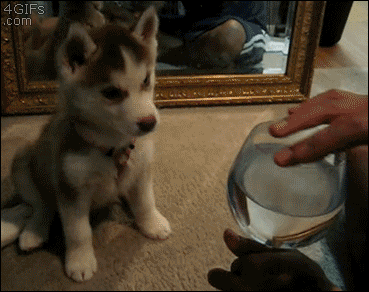Temperament
Bossy Puppies
How to handle your bossy, dominant, or aggressive puppy.
It is important to develop a good relationship with your puppy based on mutual trust and respect. The following techniques will help to foster this relationship. Different techniques should be used if your dog is older than 6 months.
FIRST:
Establish trust and a desire to please.
- Take long walks with your puppy (on leash).
- Spend 10 minutes every day brushing (grooming) your puppy.
- Attach your puppy’s leash to your waist and make your puppy go with you every where you go when you are home.
- If someone else is regularly feeding your puppy, assume that responsibility yourself.
- All the good things that happen to your puppy should come from you – not forever – but for now.
SECOND:
Establish respect and a willingness to obey using dominance techniques.
- Displace your puppy from a resting place.
- Restrain your puppy for a few minutes.
- Place hands and arms over your puppy’s neck and back, and exert pressure.
- Hold your puppy’s muzzle closed for a few minutes.
- Stare at your puppy until your puppy looks away.
- Pick up your puppy, either partially or completely.
- Push your puppy over on his side and hold him there.
- Roll your puppy over on his back.
Lots of praise when your puppy cooperates. Firm persistence if your puppy resists.
THIRD:
Assert your leadership in a firm and friendly way.
- Reward and/or praise submissive behavior.
- Hold training sessions several times a week.
- Always insist that your puppy obey all the rules.
- Make your puppy earn affection, food, and freedom.
- Firmly correct dominant and/or bossy behavior.
- Wild and unruly behavior is rewarded with a prolonged time-out.
FOURTH:
Learn to recognize and discourage dominant body language:
- Tall stiff stance
- Tail held high
- Flagging, or wagging tail in a taut stiff way.
- Ears up and forward.
- Growling, snarling, etc.
- Direct stare.
- Paws on or over person.
- Standing over someone or something.
FIFTH:
Pack leaders are aloof, they are calm, and they are self confident.
- Attention should be earned.
- Too much attention and coddling will give your puppy an inflated opinion of his place in the family.
- Everything you do with your puppy should radiate confidence and serenity.
- The pack leader is a fair dictator who enforces a well defined set of rules that members know, understand and are expected to live by.
Read and adhere to the Pack Leader’s Bill of Rights. Remember, you are the pack leader, not your puppy!
Written by: Shirley Gibson
Note:
You are welcome to share this post but ONLY IF you give credit and a link back to Teach Your Dog To Behave or shirleytwofeathers.com.
Temperament versus Personality
There are three basic temperaments:
- Submissive
- Responsive
- Aggressive
For a guide on training the basic temperament types, see this post: Temperaments and Training
There is a wide variety of personality types:
Slow * Calm * Sedate * Hyperactive * Goofy * Easily Distracted * Sensitive * Responsive * Focused * Independent * Insensitive * Unresponsive * Shy * Timid * Fearful * Combative * Domineering * Strong minded * Outgoing * Cheerful * Bossy * Lazy * Curious * Industrious
Different breeds of dogs are noted for certain qualities:
For example:
- Terriers – Combative, strong minded, aggressive
- Afghans – Independent, sensitive, uncooperative
- Border Collies – Intelligent, energetic, focused, responsive
Read about and become familiar with your own dog’s breed or combination of breeds. Mixed breed dogs tend to exhibit the qualities of the breed they most resemble.
How to assess your puppy’s temperament and personality:
- How your puppy interacts with family members in a familiar environment will give you a good idea of the personality type.
- How your puppy reacts to strangers in an unfamiliar environment will give a more accurate account of your puppy’s temperament.
What to look for:
- Dominance/aggression – ears and tail up, body stiff, hackles raised, slow deliberate movements, direct eye contact, barking and moving towards.
- Fear / possible fear induced aggression – ears back but tail up, or ears up and tail down, or ears and tail down, body stiff, hackles raised, mouth stiff, barking and backing up, crouching down, tail tucked under tummy, the tighter the tuck, the higher the level of fear.
- Submission – ears and tail down, wiggling, tail wagging relaxed and down, crouching, rolling over, paw up, licking.
- Friendliness / interest / moderate response – tail straight out, or possibly up but not high and stiff, ears perky, mouth open, body relaxed, tail wagging in a relaxed happy way, playfulness, caution without fearfulness.
Written by: Shirley Gibson
Note:
You are welcome to share this post but ONLY IF you give credit and a link back to Teach Your Dog To Behave or shirleytwofeathers.com.
Temperaments and Training
Your dog’s basic temperament is genetically encoded into his/her DNA. What follows is simple explanation of what type of training works best with each of the basic temperaments. For an explanation of temperament vs personality, and what to look for, see: Temperament vs Personality
SUBMISSIVE / fearful / combative
Can be a “fear biter,” must be handled carefully and calmly. Corrections must be firm but nonthreatening and impersonal. Lavish praise and gentle handling are very important. Can be very difficult to train.
SUBMISSIVE / sensitive / timid
Requires special handling, needs patience and understanding, but should not be coddled or spoiled. Too much coddling may turn this dog into a neurotic mess. Be firm, but use mild corrections. Lavish praise and a happy positive attitude goes a long way.
RESPONSIVE / sensitive / moderately submissive
Willing to please, eager to learn, quick to understand, responds well to mild corrections and generous praise. Care must be taken not to overly intimidate this type of dog. Can be quite bossy and naughty if spoiled.
RESPONSIVE / moderately aggressive
Willing to please, eager to learn, quick to understand, responds well to confident handling, firm corrections and generous praise. Easily spoiled. Can become a bratty “problem child” if not given rules and taught respect.
DOMINANT / strong minded / determined
Stubborn, does not like to submit to authority. Is sometimes willing to please, but not necessarily on your terms. Requires patient, persistent and firm handling, will take every opportunity to resist. Corrections should be vigorous and full of confidence. You must be assertive and demanding if you want this dog to respect and obey you. Generous praise is important, but it must be earned.
DOMINANT / aggressive
Resists learning, not eager to please. Requires special handling. You must be firm and strong minded with this dog. Avoid direct confrontations as a dog with this temperament will not be able to resist fighting back. Can be dangerous and difficult to train when fully matures.
Variations of the Basic Types
CALM / slow/ easy going
Willing to please, but not eager. Willing to learn, but not quick to respond. Praise, patience, and tolerance are needed. Go overboard with praise. Do not use harsh corrections with this dog.
EXCITABLE / high energy
This high energy type dog is easily distracted and excited about pretty much anything and everything. Requires firm but calm and patient handling, vigorous corrections, and quiet praise. Is often eager to learn and quick to understand, but may not be so willing to please.
INDEPENDENT / aloof
Self reliant and often mistrusting. Not a “people” dog. A good rapport is essential, corrections must be firm, but never harsh. Praise is very important. These dogs respond well to long walks, and a good run is an effective reward or form of praise. The more time you spend with this dog, the easier it will be to build the necessary rapport.
Written by: Shirley Janner
Note:
You are welcome to share this post but ONLY IF you give credit and a link back to Teach Your Dog To Behave or shirleytwofeathers.com.





